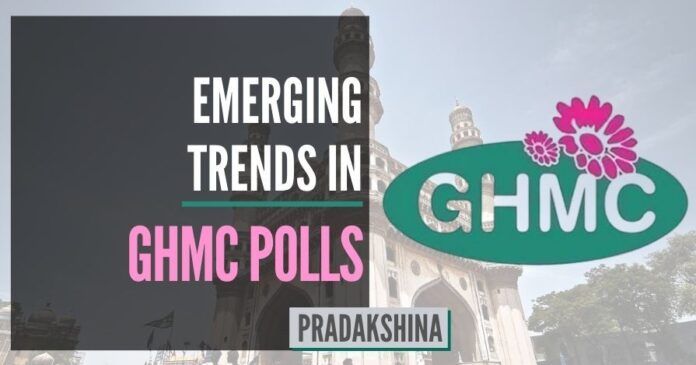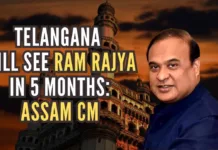
SEC used the outdated ballot papers instead of EVMs
The recent December 2020, Greater Hyderabad Municipal Corporation (GHMC) election results came as a shot in the arm for BJP which won about 1/3 wards in a largely two-way contest, after an electoral drought of several years. The three main parties Telangana Rashtra Samithi (TRS), Bharatiya Janata Party (BJP), and All India Majlis-e-Ittehad-ul-Muslimeen (AIMIM) had approximately got 1/3 seats each. TRS led by CM K Chandrasekhar Rao continued to win all elections on the strength of Telangana sentiment since the division of Andhra Pradesh state in the year 2014. Since 2014, despite promises of making Hyderabad a global city, the metropolis has in fact got reduced to a district headquarters with garbage overflowing everywhere, filthy drains, pot-filled roads with none addressing civic issues. In an age where political leaders are professionals and work 24×7, Mr. KCR is making history as a CM who never attended office.
With a low voter turnout of only 45%, BJP won 49 seats with 35.5% votes, whereas with roughly half of that vote percentage at 18.7%, MIM won 44 seats. It is also curious that MIM which is called AIMIM and contested elections in many states including UP, Maharashtra, and Bihar recently, contested only 51 out of a total of 150 seats in Hyderabad, and only in the predominantly Muslim-dominated old city and a few other areas. MIM facilitated a smooth contest for TRS against BJP, by not contesting in the rest of the city, as TRS is its friendly party. By and large Muslim community voted MIM en masse again, whereas the Hindu vote got divided and went to several parties. Hyderabad has a substantial number of converted Christian voters too and it seemed to have gone to TRS as Mr. Jagan Reddy’s Yuvajana Sramika Rythu Congress Party (YSR) supported KCR. However, TRS which has many MLAs and MLCs from the Greater Hyderabad region would have enough ex-officio votes to win the indirect election for the Mayoral seat. Even if TRS succeeds in ruling the Hyderabad Corporation in the current term, it is clear that BJP has consolidated its political strength and is going to become the foremost challenger to TRS in the next assembly elections in 2023. GHMC has about 20% of the state assembly seats in its area, and hence it shows the trend for the rest of the state. It is certainly a huge boost for Mr. Bandi Sanjay, MP who spearheaded the campaign, and who was harassed by the state police and even attacked by the TRS cadre. It is also interesting that the campaign reflected the ethos and the aspiration of the city to be called by its original name Bhagyanagar, it is hoped that BJP leaders may make an effort in that direction. Hyderabad being the gateway of the south, it could herald BJP’s lotus bloom all over the south.
Not many in today’s generation are aware that Hyderabad state didn’t get freedom with the rest of the country in August 1947. The Nizam wished that Hyderabad become a part of Pakistan or remain an independent state without integrating into India.
The election had many pitfalls, the voter electoral rolls in several areas were revised just two weeks before the elections, thousands of voters couldn’t vote as they didn’t know their voter numbers, the database wasn’t updated and polling booths were not known. Similarly, thousands of voters couldn’t exercise their franchise, as their names were deleted from the voter lists, the same problem arose in the previous GHMC elections in 2016 too. The State Election Commission officials failed to do their duty in revising and updating the voter database and in informing the electorate on the changes. As the State Election Commission issued a circular in the middle of the night before the election day, on counting ballots marked with even a pen instead of ink, BJP moved the High Court, which dismissed the SEC orders. It is also unclear as to why the State Election Commission used the outdated ballot papers after nearly two decades, instead of EVMs. In the previous elections, EVMs with VVPATs were used. The above two issues give rise to speculation whether the ruling party was intending to manipulate the elections in their favour as the state machinery is under their control. Nevertheless, it is a serious issue as thousands of eligible voters couldn’t exercise their franchise.
History of Nizams and MIM
Not many in today’s generation are aware that Hyderabad state didn’t get freedom with the rest of the country in August 1947. The Nizam wished that Hyderabad become a part of Pakistan or remain an independent state without integrating into India. The old Hyderabad state which consisted of present Telangana, three districts from present-day Karnataka, and five districts from today’s Maharashtra, was the largest princely state in then British India.
MIM (Majlis-e-Ittehadul Muslimeen) has a chequered history and was established with communal overtones to support the Nizams of Hyderabad and to spread the Islamic agenda successfully all over the old Hyderabad state. The Nizam banned the Congress party and helped the growth of MIM. MIM was founded in the year 1927, and after the death of Bahadur Yar Jung who was president of MIM in 1944, the fundamentalist Kasim Rizvi became its leader. Kasim Razvi led the notorious Islamist paramilitary organization which oppressed, tortured, and killed Hindus during the infamous Razakar movement. The few remaining people from that generation recall the atrocities of razakars with horror. Countless testimonies have been written, especially in Marathi and Kannada. After years of continuous violence and brutalities, the Government of India’s military action Operation Polo in September 1948 freed Hyderabad state from Muslim rule, about 13 months after the rest of India became independent; significantly the Nizam’s army surrendered within days. MIM was banned in 1948, and Kasim Razvi was jailed from 1948-57 and was released in 1958 on the condition that he would move to Pakistan. However, the party survived as he handed it over to Abdul Wahid Owaisi who revived it in 1958. Since then the Owaisi family has controlled the party for generations, the current Hyderabad MP Asaduddin Owaisi is his grandson.
Changing Hyderabad
MIM has methodically over the decades changed the profile of the old city of Hyderabad. A once composite Hindu-Muslim area, today it is almost entirely Muslim-dominated. Observers point out that there was overt pressure on the Hindu community to leave the old city area, and many sold their properties, shops, and other businesses and moved to other parts of the city. This kind of ghettoization has accelerated in the recent past. MIM leaders are known to boast that GHMC officials cannot dare to collect water and electricity bills etc, in the old city. Some localities have large chunks of Yemeni descendant Chaush population, and some areas like Barkas are known for their high Arab influence. Another significant development has been that most of the trades which cater to everyday needs, like vegetables, fruits, flowers, dairy, trading in machines and spare parts, etc, have largely been overtaken by the Muslim community in the city. Observers have noted that there is a big change in the attires too, with more women wearing burkhas and men growing beards.
MIM seems to be following the single-point agenda of consolidation of Muslim vote-bank wherever it contests in India. As MIM won 5 seats in the Bihar assembly elections, in the Muslim-dominated, communally sensitive border areas of the Seemanchal region, alarm bells are ringing in the security establishment of the country. In the past, when NIA was investigating ISIS terror modules, several people were arrested in Hyderabad and MIM provided legal aid to them, describing it as their constitutional right. Today, there is a larger consensus that elections should be fought on issues of development, especially the ‘bijli –Sadak-pani’ issues relating to the poor. However, the single-issue agendas of some political parties, have made caste/ religion their singular focus in the elections, with vote-bank consolidation as the only agenda. In such a scenario, broad-based development-oriented democratic mandates are getting hijacked with the re-emergence of old-style identity politics. It is a matter of concern if the politics of the country turns to caste/ community/ religion/ region/ ethnicity/ language as the focus in the electoral arena, in which issues of development, reforms, economy, corruption, and national security do not matter.
Note:
1. The views expressed here are those of the author and do not necessarily represent or reflect the views of PGurus.











Even if elections become religion based, corruption can be tackled as the Hindu dharma proposes purity and honesty in life.